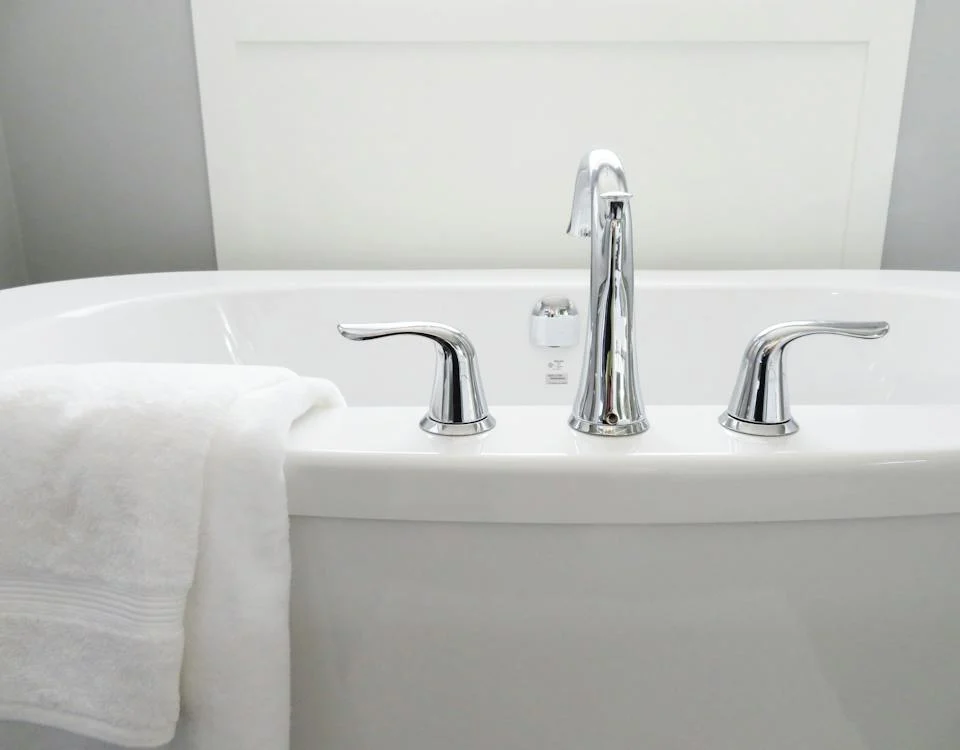Faucets are like the crown jewels in bathrooms. It’s available in many different shapes, styles, and finishes. Since the bathroom is a highly functional room, one brilliant way to inject some style and décor is through your choice of good bathroom faucets. Think of it as bathroom bling that suits your style, needs, and budget.
Changing out the faucet in your bathroom can be overwhelming. Here’s what you need to know about faucets and tips to help you make an informed decision:
1. Know the faucet types and match it to the existing hole openings in your sink, bathtub or shower
If you’re buying a new faucet to an existing sink or buying a whole new sink ensemble, make sure the faucet you buy matches the hole opening/s in your sink. Here are the common types of faucets:
- Single-hole/ vessel faucet – the spout and handle (which is often a single lever) are combined into one unit. This is for use on a sink with 1 pre-drilled hole. Some models of this type of faucet include a deck plate to cover other existing holes on the sink. This is ideal for smaller sinks, like those in vanity and powder rooms.
- Center-set faucet – has 3 holes, with outer holes drilled 4 inches apart. It often has two handles or a single lever mounted on a deck plate. This type of faucet is ideal for most bathroom sinks.
- Widespread mount faucet – has three separate pieces: a spout and two handles, with three pre-drilled holes that are 8 inches apart. The three pieces of the faucet tend to be larger than other types of bath faucets. It’s used on bathtubs and large sinks.
- Mini-spread faucet – a smaller version of widespread mount, this type of faucet fit 4-inch configurations on sinks with three pre-drilled holes. It also has two handles and one spout.
- Wall-mounted faucet – has the spout and handles mounted to the wall. Unlike other types of faucets with water supply lines coming up from the sink, this one has the plumbing installed into the wall. It is popular along with vessel-type sinks that need faucets with longer spouts that extend over the top of the bowl.
So, if you have:
- One hole in the sink or counter – use a single-hole faucet
- Three pre-drilled holes that are 4 inches apart – use a center-set or mini-spread faucet
- Three pre-drilled holes that are 8 inches apart – use a widespread mount faucet
2. Choose what material you want your faucet to be made of
Manufacturers of fixtures have now created more options for faucet finishes, thanks to the protective clear-coat sealers brought by modern technology. Before, people are wary about choosing a metal faucet because it’s prone to rust, but now you can choose from different metals and different finishes.
Most metal finishes used for faucets and other bathroom fixtures are brushed, polished, satin and antiqued. Metal types used as faucets include stainless steel, chrome, copper, brass, bronze, nickel or porcelain and vitreous china.
It’s best to stick with the same type of finish for all your bathroom hardware, such as faucets, shower heads, towel racks, lighting fixtures and doorknobs for a cohesive design. But if you’re one of those people who prefer a more mixed look, be sure to keep it balanced.
3. Consider your overall style scheme
The interior design style of your home should determine how you can best decorate your bathroom. Once you get established in your design style, you will know what fixtures go best with your space. Though there are no rules – it’s your bathroom and your faucet after all – getting a closer combination of styles makes a more pleasing overall effect. It goes for choosing what faucet to go with your sink and bathtub.
If your bathroom style is traditional, go for crossbar-handle faucets in brass or chrome, or ceramic-covered lever faucets for an old-fashioned appeal. Warmer metals like copper, brass, and bronze work well in traditional bathrooms. For a transitional look, a matte-finish faucet looks fitting.
If your style leans to the modern and contemporary, choose faucets that have a smooth and polished finish and minimalistic design. Materials such as chrome, nickel, and stainless steel are common for this style.
4. Choose safe and environmentally-friendly faucets
Form and aesthetics aside, your faucet of choice must be certified and lead-free. Faucets that are not certified can contain lead and other harmful elements that can harm you and your family. Uncertified faucets are more likely to be bought online, so it’s still best to shop at trusted hardware stores. Always look for the NSF (National Sanitation Foundation) Seal of Certification. It’s also best to purchase a WaterSense label faucet, as these types of faucets reduce water usage up to 30% or more.
You can also consider getting an aerator for your faucet to lessen water usage and save water (and money on your bills). It’s a small screen you can attach on the end of the faucet to introduce air to the water flow. This softens the stream and makes it splash less, so you can still wash your hands thoroughly but using less water.
5. Determine your budget to eliminate choices
For most homeowners, the budget is a big deciding factor when purchasing a new fixture. Faucet prices range at around $50 to more than $1,000. Get the best you can afford. If you’re looking for cheaper faucets, beware of those with plastic shells or handles, as their durability and resistance to scratches will most likely be disappointing.


